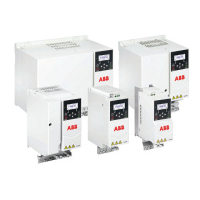■
Identifying the grounding system of the electrical power network
WARNING!
Only a qualified electrical professional may do the work instructed in this
section. Depending on the installation site, the work may even be categorized
as live working. Continue only if you are an electrical professional certified
for the work. Obey the local regulations. If you ignore them, injury or death
can occur.
To identify the grounding system, examine the supply transformer connection.
See the applicable electrical diagrams of the building. If that is not possible,
measure these voltages at the distribution board, and use the table to define the
grounding system type.
1. input voltage line to line (U
L-L
)
2. input voltage line 1 to ground (U
L1-G
)
3. input voltage line 2 to ground (U
L2-G
)
4. input voltage line 3 to ground (U
L3-G
).
The table below shows the line-to-ground voltages in relation to the line-to-line
voltage for each grounding system.
Electrical power system typeU
L3-G
U
L2-G
U
L1-G
U
L-L
TN-S system (symmetrically grounded)0.58·X0.58·X0.58·XX
Corner-grounded delta system (nonsym-
metrical)
01.0·X1.0·XX
Midpoint-grounded delta system (non-
symmetrical)
0.5·X0.5·X0.866·XX
IT systems (ungrounded or high-resist-
ance-grounded [>30 ohms]) nonsymmet-
rical
Varying level
versus time
Varying level
versus time
Varying level
versus time
X
TT system (the protective earth connec-
tion for the consumer is provided by a
local earth electrode, and there is anoth-
er independently installed at the gener-
ator)
Varying level
versus time
Varying level
versus time
Varying level
versus time
X
Electrical installation 67

